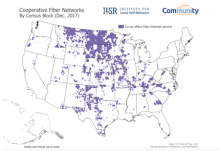
Fast, affordable Internet access for all.

Decades after bringing electricity and telephone services to America’s rural households, cooperatives are tackling a new challenge: the rural digital divide. New updates to our report Cooperatives Fiberize Rural America: A Trusted Model for the Internet Era, originally published in 2017, illustrate the remarkable progress co-ops have made in deploying fiber optic Internet access across the country.
“Cooperatives should be the foundation for bringing high-quality Internet service to rural America... Small towns and farming communities need robust Internet service to support their local economies, educate themselves, and generally improve their quality of life. Cooperatives have quietly proved that they can build Fiber-to-the-Home networks that are capable of speeds of greater than 1 Gigabit per second (1,000 Mbps). More than 140 cooperatives offer gigabit service to residents or businesses.”
The report features new maps showing overall growth in areas served by co-ops, as well as expanded information about state legislation that supports co-op investment in broadband networks. A few important takeaways:
Co-ops have proven that this is a model that works. With increased support from federal and state governments, they will continue to connect rural Americans to economic and educational opportunities otherwise denied to them.
Read the full report [PDF] here.
*This resource has been updated since it's original reliease in 2017. Access all versions of the report at the Reports Archive for this resource.
